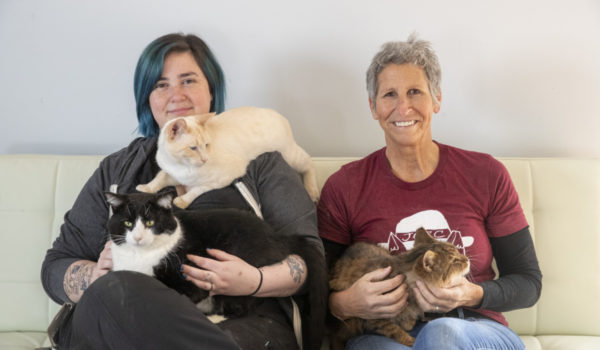
JCCC sheds light and love on feral felines
By Kaylin Brian // photography by Jana Jones
When Janie Blakeley first moved to Greenwood Estates a little over 20 years ago, she found herself with a cat problem. “There were cats everywhere,” she says. “Everywhere. At one time, I was feeding like 24 of them.”
Some of them were strays and some of them were feral, but the necessary step for all of them was the same: getting them spayed and neutered. Blakeley worked with an Indianapolis organization, Foundation Against Companion-Animal Euthanasia Low-Cost Animal Clinic, to have her feral colony spayed, neutered and released. The years passed, and eventually she was referred to a closer resource: Johnson County Community Cats.
JCCC was founded in 2013 by Janet Gorrell, now the organization’s president. An animal lover her whole life, Gorrell felt that something needed to be done about the treatment of feral cats. “They were not given a fair shake, and someone needed to be a voice for them. So I spoke up,” she says.
Eventually, Gorrell was joined by Regan Lambert, who serves as the organization’s vice president and director. As a cat lover herself, with an extensive background in animal care, Lambert also felt that feral cats needed a voice; their population control measures included only lethal options. “While I was volunteering at animal shelters, I would see ferals come in, and with no options for them, I would see them euthanized,” she says. “I didn’t feel that was the correct course of action for them.”
Both Gorrell and Lambert knew there was a kinder method of population control: trap, neuter, release or TNR. For a $30 fee, JCCC will TNR and vaccinate a community cat.
When a cat goes through TNR, it is caught in a humane trap, taken to an organization like JCCC to be spayed or neutered, and then returned to the area it was trapped from after having its ear tipped, that is, the surgical removal of the tip of its ear to alert people and animal control that the cat is a fixed feral. Some programs, including JCCC, will also vaccinate the cat against rabies. The step into the humane trap is truly the feral cat’s first step to an improved life.
Community of cats
Originally, JCCC only dealt with the trap-neuter-release of feral cats, also known as community cats. They are a mix of feral cats and abandoned pets that gather in a colony. Because an unspayed female cat can have up to five litters of kittens a year, the feral cat population will quickly spiral out of control without intervention. That’s where TNR comes in. The JCCC website describes TNR as a “nonlethal strategy for controlling the overpopulation of community cats (ferals and strays) and improving the overall quality of life for not only the community cats but for the wildlife and people.”
TNR is crucial, Lambert says, because without it, the only option for a majority of those feral cats is ending up in a shelter. “And in a shelter, basically the only option for a feral cat is euthanasia,” she says. “At the end of the day, if you’re just euthanizing ferals, you’re not ending the cycle of feral cats continuing to have kittens.” And, unfortunately, there are misconceptions about community cats that continue to perpetuate that cycle as well. Lambert says people tend to view outdoor cats as a nuisance.
“It’s not like with dogs,” Lambert says. “People see a dog alone outside and think, ‘Oh, no, this is a stray. I need to help it.’ But when they see a cat, they think, ‘It’s getting into stuff, it’s going to the bathroom in my yard, it’s killing wildlife.’”
In fact, the opposite is true. Community cats that receive proper population control, such as TNR, add many benefits to the area in which they reside. They control the rodent population, slow the spread of rabies because they are vaccinated, and they stop other, unaltered cats from entering the community. Lambert calls this the vacuum effect. “Community cats that have been through TNR will deter other cats from entering the territory,” she says. “That itself eliminates undesirable behavior like yowling, spraying and fighting.”
Small but mighty
JCCC is the only cat specific rescue and TNR program in Johnson County. Since its inception, it has become a 501(c)(3) nonprofit organization and has expanded its critical services beyond TNR. For a $60 fee, it offers low-cost spay/neuter of pet cats; fostering; a cat food assistance pantry for low-income households and community cat caregivers; and outreach and education programs to inform the community about responsible cat ownership. Additionally, organization members pull rescue cats from high-kill animal shelters, rehabilitate them for adoption and orchestrate adoption for friendly feral cats, kittens and cats surrendered by their owners.
Dedicated to providing the best care for every cat that crosses their paths, to date JCCC volunteers and veterinary caregivers have spayed and neutered more than 5,000 cats. They have adopted out hundreds of friendly cats to forever homes. As a 100% volunteer-based organization, JCCC’s biggest need is assistance in trapping feral cats for TNR. “We need more cat trappers,” Lambert says. “For the most part, it’s me and Janet, and it gets difficult to balance the daily running of the organization with trapping cats for people who can’t.”
Volunteers can put in an application on the JCCC website; tasks include helping with anything from trapping to fostering to cleaning litter boxes. Since receiving TNR assistance from JCCC all those years ago, Janie Blakeley has returned the favor by helping to trap and foster cats as well. “JCCC is great to work with,” she says. “And I think most people want a humane solution to feral cats. We’ve created the problem because we get animals and then we abandon them. We have to be part of the solution.”
In the end, JCCC’s overall goal is simple, according to Lambert: “We want to shed a positive light on cats and their unique, individual personalities. Cats get overlooked far too often, but they are just as worthy of love and care as any other animal.”
To learn more about Johnson County Community Cats, visit jcccats.org.
Photo: Regan Lambert and Janet Gorrell


